|
|
THE MANUFACTURING OF ANCIENT STONE BEADS
In the
subsequent chapters, I will delve into the marvels of
ancient bead production. While this is not intended to
be a scholarly treatise, it does invite you to be
intrigued and inspired.
The intricate process of bead making, dating back to the
enigmatic Indus Valley civilization, necessitated a
division of labor, with craftsmen specializing in
different stages of manufacture. A single artisan was
unlikely to execute all the steps involved in the
creation of a bead, these being:
Sourcing
the material
Shaping
Cutting
Polishing
Drilling
In some instances, each of these steps would be
performed by a different individual. However, in other
cases - varying by location and era - an artisan might
possess expertise in several of these areas. This
compartmentalization of bead-making labor can be traced
back to the ancient
Harappan culture 2500
BC.
It underscores the earliest signs of urbanism, given
that civilization inherently requires a division of
labor.
THE SURFACE
We'll commence our exploration by studying the surface
of the bead and conclude at the bead hole. Over time,
ancient beads acquire a sort of tarnish known as patina.
Primarily, there are two types of patina: one created by
time and earth, and the other by
time and human skin.
Firstly, we'll examine what I've termed as the 'sweat of
the earth'. This patina takes shape over decades due to
the combined effects of soil, dirt, and temperature
fluctuations, triggering a chemical reaction on the
surface of the stone bead.
Excavation Patina on Ancient Beads
The term 'excavation patina' refers to the kind of
patina a bead acquires, not from wear and tear, but from
being buried underground for centuries. This patina can
be classified into two categories: one that arises from
the bead's interaction with the earth, and a more subtle
sheen formed through the bead's exposure to air over
thousands of years! This latter form can be observed in
beads found in burial caskets. The first kind of patina
I've opted to term as the 'sweat of the Earth'.
Three Kinds of Earth - Acidic, Alkaline, or Neutral
PH-Value
Primarily, there are three types of soil in which beads
can undergo their often millennia-long slumber:
Alkaline, Acidic, or PH-neutral soil.
Three Distinct Types of 'Sweat'
The ultimate appearance of an ancient stone bead is a
consequence of three types of sweat:
The sweat of human endeavor
The sweat from generations of human skin
The sweat of the Earth
CALCIFICATION - THE SWEAT OF EARTH
& BODY
Calcification
is a process that involves the depositing of calcium
salts. The calcification not only creates a unique
patina on the bead but also serves as a testament to its
age and history. The extent of calcification can provide
clues about the bead's burial conditions, including the
composition of the soil and the presence of organic
matter.
This calcification can manifest as a crust or a layer of
white or yellow coloration, depending on the other
minerals present in the soil. The texture of this
calcified layer can vary, ranging from a smooth coating
to a rough, chalky crust. The process takes place in a fascinating intersection of
natural chemistry, human history, and artistic beauty
Calcification takes Centuries
The calcification process on the surface of the beads is
slow and gradual. Over centuries, the calcium ions in
the soil solution can adhere to the surface of the bead.
Initially, this might just alter the coloration of the
bead, creating a subtle patina. However, over time, as
more and more calcium ions attach to the bead's surface,
a thicker layer of calcification can form.
This often occurs in damp
soil abundant in calcium, featuring a pH value either
below or above 7.
The Mineral Body-Shadow
In the case of ancient beads, this process can
occur when they are buried in calcium-rich environments
over long periods of time, particularly in soils rich
with decomposing organic matter like human remains.
Human bodies, along with many other organisms, have a
significant concentration of calcium, predominantly
housed in the bones and teeth. Over the course of time,
as a body naturally decomposes, the calcium along with a
variety of other minerals contained within the skeletal
structure, are gradually released and infiltrate the
surrounding soil. This particular phenomenon is commonly
described as the body's "mineral shadow", a signature
imprint left behind.
In circumstances where beads or other types of artifacts
are interred in conjunction with the body, they can
potentially come into contact with and absorb these
released calcium salts and other minerals. This exposure
often triggers a unique calcification process, distinct
from other natural or environmental calcification
processes.
|
|
|
|
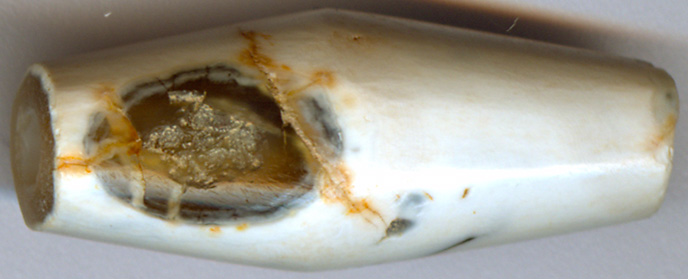
A Burial calcificated
Bead from the Indus Period. Note the thickness
of the calcified layer in the left cut side of the bead.
|
This suggests that beads
which have been ritually interred along with their
possessors, often termed "burial beads," generally
exhibit a higher degree of calcification. This type of
calcification, induced by proximity to decomposing
remains, generally results in a far more pronounced and
accelerated mineral encrustation on the surface of the
beads or artifacts, provided they are composed of a
material susceptible to such absorption. The resulting
patina not only serves as a testament to the artifact's
history but also as a tangible link to its interment
alongside human remains.
Pictured below displays an
arresting ancient agate burial eye bead. The white and yellow
tints are confined only to its surface. I'm sure you
would agree, the outcome is truly awe-inspiring! The
distinctive clouding is likely the result of minerals,
particularly calcium, permeating into the bead's surface
over an extensive period.
|
|
|
|
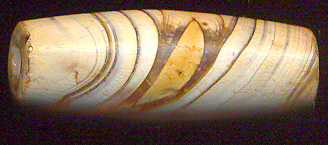
25 * 10 mm
A mysterious colored agate Eye Bead.
|
It is a rare occurrence for a bead to gain additional
aesthetic appeal through its interaction with the sweat
of the earth, yet a fair number of Indus beads have
derived their charm from the calcification process. This
might be attributed to the fact that calcification is a
slow and meticulous process. Over centuries, the
accumulating calcification not only transforms the
beads coloration, but also bestows it with a testament
of time, embedding in it a story of the ages it has
silently witnessed.
|
|
|
|

|
Below can observe some more ancient beads that have been colored by the soil. Note the whitish dots on the
surface of the bead. They have not contributed to the
beauty of the beads.
|
|
|
|
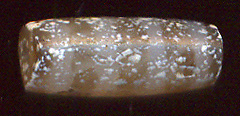

|
Below is an image of an expansive carnelian bead. At first
glance, this bead could easily be mistaken for a recently
crafted piece, were it not for the subtle signature
discoloration - a telltale testament to its centuries-long
slumber in the caustic embrace of acidic soil.
|
|
|
|
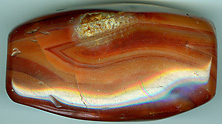
|
Etched Burmese carnelian bead with oil & gas patina
Featured below is
an etched, elongated carnelian bead hailing from the
lower region of the Kachin state in Burma. Here, the
intense white hue gracing the bead's surface is not a
product of the calcification processes we've previously
discussed. Instead, this bead's unique patina is a
result of a rare combination of oil, gas, and pressure
over time, leading to a distinctive and stunning
transformation of the original carnelian surface.
|
|
|
|

63 * 10,5 mm
|
|
Burma, being a land
abundant in natural resources such as oil and gas, hosts a unique array
of ancient beads exhibiting the discoloration illustrated above.
Excavation beads found in PH-neutral surroundings
In circumstances where a bead has been nestled in soil with a pH value
below or above 7, there will invariably be noticeable chemical evidence
of the bead's interaction with the earth on its surface. This would be
the case even without the chemical interaction with the
"mineral shadow". of a
corpse. Even when not overtly colored, as showcased by the beads above,
the intricate and subtle ridges crafted during the polishing process
gradually fade as the years pass.
However, in instances where beads have been slumbering in pH-neutral
soil or, more significantly, in sand, the bead's surface can appear as
if it were crafted only yesterday! The same is the case for beads found
in pots or burial caskets. In such instances, the only factors capable
of confirming whether the bead was created a millennium ago or more
recently are the sheen of the bead and the nature and quality of its
craftsmanship. Even beads that have rested in pH-neutral sand
distinguish themselves from recently crafted counterparts. They possess
a gentler shine and a more subdued reflection when subjected to an
intense light source, particularly sunlight.
|
|
|
|
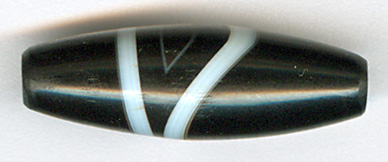
Burmese Sulemani agate bead
|
|
Displayed above is an exquisite ancient Burmese bead
unearthed from the sandy soil of Matehtilay, Maline in Burma.
Interestingly, the majority of Burma has acidic soil. Lower Burma hosts
small pockets of alkaline soil. However, the central part of Burma,
including regions like Matehtilay, encompasses extensive areas where the
sandy soil maintains a neutral pH value. In such instances, the true age
of the bead betrays itself only through its gentle sheen, referred to as
patina, and the distinct intricacies of its craftsmanship.
PH- map of Myanmar
|
|
|
|

Red = acid, blue = alkaline, yellow = neutral
|
The beads
showcased above, alongside those displayed below, have been discovered
in the indicated yellow region. In such an environment, the only
influencing factor upon the beads is the air surrounding them.
|
|
|
|
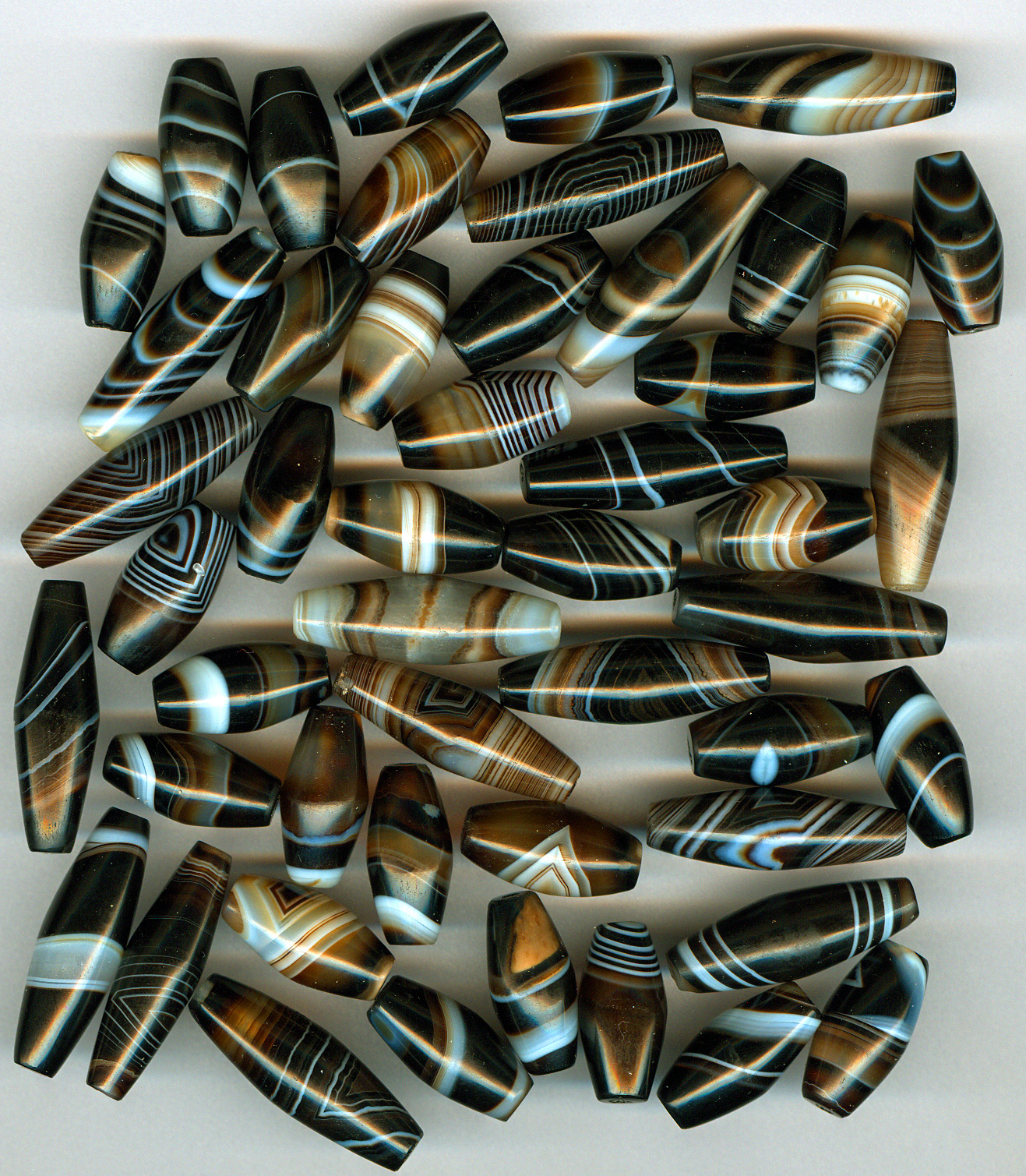
Click on picture for larger image
|
Excavation
patina
Excavation patina is a unique feature that emerges over
time, particularly in circumstances where a bead has
been buried in pH-neutral soil or safely stored in a
non-reactive container, such as a clay pot, in a place
free from sub-zero temperatures. Determining the age of
these beads can be challenging, as there may be fewer
obvious signs of age. Yet, the ceaseless interaction
with time, fluctuating humidity levels, and changing
temperatures results in the formation of a subtle and
gentle sheen or patina on the stone bead. This
understated patina softens the bead's overall
appearance, bestowing an elusive but distinct indication
of antiquity.
|
|
|
|
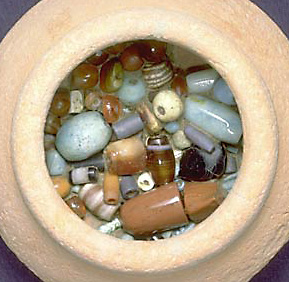
|
|
The image above
showcases an excavated casket of beads from the
Harappan culture. Take a moment to observe the
luster of the white and brown beads. They appear as
though they were freshly crafted. However, don't be
fooled! These are indeed ancient artifacts. It often
requires an expert's discerning eye to differentiate
between the vibrant shine of a newly made bead and the
"dusty" patina that adorns an ancient excavated one.
These
excavated beads often bear no signs of extended wear. In
many cases, they were briefly used or not used at all
before they were placed in burial caskets. These beads
served not only as symbols of the deceased's social
status, but also as talismans or even as currency for
the afterlife. At times, they were strategically
positioned in the heart of Buddhist stupas, acting as
revered relics intended to sanctify and purify the
entire structure.
Oxidation Patina
The etched bead displayed below carries an original
oxidation patina, a quality that is difficult to
accurately represent in digital images.
Over centuries, the
interaction between the bead's surface and the
surrounding environment leads to an oxidative reaction,
which causes the formation of an oxidation patina. This
patina is essentially a thin layer that forms on the
surface of the bead due to this long-term chemical
reaction.
|
|
|
|
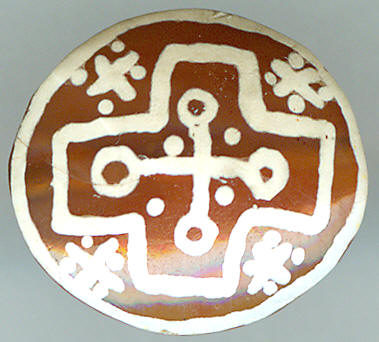
|
|
Oxidation patina often imparts a distinct characteristic
to the bead, lending it an air of authenticity and
historical significance. This patina is not just a
product of aging but also of the environment in which
the bead existed.
One of the
challenges in analyzing ancient beads is that it's
difficult to capture the subtle qualities of an
oxidation patina through digital images. The surface
changes are often subtle and can vary greatly in color,
texture, and depth, making it hard to convey through a
flat image. However, when observed in person, this
patina often adds an extra dimension to the bead,
serving as a testament to its journey through time.
In the case of the etched bead displayed below, the
oxidation patina tells a story of its 2,000-year-long
existence, subtly altering its surface while
highlighting its intricate etched designs.
Displayed below is
an exquisite hexagonal bead, which likely never saw any
use and is only a few centuries old. In cases like
these, determining the bead's age can pose a challenge.
We must in such cases have a deeper look at the design
of the bead.
Regardless of its exact timeline, one can't deny the
striking beauty of this bead. Its detailed craftsmanship
and unique shape offer a glimpse into the artistry and
tradition of bead making.
|
|
|
|

Antique Hexagonal carnelian bead
|
|
The
Stories in the Cracks: Age Markers of a Thousand Cold
Winters
When an agate bead has had the fortune to 'sleep'
for hundreds of years in areas where winter temperatures
dip below zero, moisture within the bead creates small,
circular cracks on its surface. This phenomenon results
from the expansion of water molecules as they transform
into ice.
Such elegant signs of age are mostly evident in beads
from the Himalayas, Afghanistan, and other regions with
frosty winters. However, beads that have been housed in
warmer climates might also occasionally showcase these
marks of age. In such situations, these cracks are most
likely produced by sudden shifts in temperature or
possibly exposure to high heat, as might be experienced
in fires from funeral pyres.
Moreover, the manifestation of these cracks also relies
on the hardness and 'porousness' of the stone. A dense
agate stone bead containing minimal water or other
chemical impurities can even endure the harsh winters of
the Himalayas without yielding to these cracks.
|
|
|
|
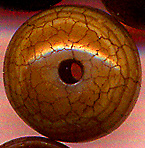
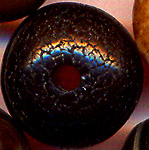
Bhaisayaguru beads from Afghanistan with beautiful cracks
|
In the contemporary bead market,
artificial methods are used to simulate the natural age
markings found on genuine ancient beads. One such
technique involves repeatedly transferring new beads
between a microwave oven and a freezer, inducing cracks
that superficially resemble those made naturally by cold
winters.
|
|
|
|

Fake DZI bead
|
|
Examine the Dzi bead from Taiwan in the
image above closely. You'll notice numerous small, artificially induced
indentations on the surface. These indentations aim to mimic the
appearance of ancient frost patina, but they lack the circular shape of
natural cracks. Furthermore, take note of the bead's dusty sheen,
another indication of artificial aging. Owing to their astronomical
value, Dzi beads are among the most frequently counterfeited beads in
the market. This bead, with its artificial 'cracks' and contrived sheen,
is a clear example of a counterfeit bead. As such, it is vital to be
aware of these deceptive practices when collecting or purchasing beads.
THE SWEAT
AND POLISH FROM HUMAN SKIN
Beads, particularly those of
antiquity, acquire a distinct patina over time, not solely from their
exposure to the natural elements - earth, wind, fire - but also from
consistent interaction with human skin. In essence, this is a form of
human sweat patina. This process entails the chemical reaction between
the bead's surface and the natural oils and salts found in human sweat.
The polishing of a bead doesn't end when it's removed from the tumbler
or detached from its maker's polishing stone. At that point, human skin
assumes the role of polisher. As the bead is passed down from one
generation to the next, it undergoes a slow-motion relay race,
undergoing subtle changes in texture and appearance throughout its
journey.
The human skin, in this context, acts as a soft, biological abrasive. It
gradually smoothes and polishes the bead over the years, contributing to
its final look, a look that is a constant work in progress as the bead
continues to interact with human skin.
Beads have held significant cultural and spiritual importance across
various cultures since the Neolithic era. These ancient societies often
attributed magical or mystical powers to beads. This could potentially
explain why beads were so often in contact with human skin, being worn
regularly as adornments or amulets. The human sweat patina is not just a
mark of age but a testament to the bead's intimate relationship with
human history, culture, and belief systems over centuries.
Shamanic sweat & rechargeable talismans
In ancient times, long before religion became formalized and organized,
each clan or tribe had a shaman. Serving as a conduit, the shaman
negotiated and facilitated the communication between the invisible
spirit realm and the mundane world of everyday human existence. The
wearing of beads in these societies was not a mere adornment but a
protective act - a shield against the myriad of spirits believed to
reside in caves, mountains, waterfalls, and trees in the animistic
worldview.
As time progressed, the role of the shaman evolved or was supplanted by
holy men or priests. Nevertheless, in cultures where beads were believed
to possess magical properties, it was crucial for these beads to be worn
in direct contact with the skin, preferably close to the heart.
Consequently, we see numerous ancient beads that bear the marks of
prolonged skin contact.
Holy Capital
While it wasn't only the shamans or holy men who wore beads, their
significance in religious contexts cannot be underestimated. For
instance, in India, the commonly used term for beads, "Babagoria" or
"Baba Ghori", translates to "holy man's bead", reflecting the
deep-rooted belief that these beads were primarily worn by religious
leaders. An ancient Indian scripture from the Gupta period, Vijjalagga,
even posits that a bead's value is enhanced through the act of wearing
it (Indian Beads, Shantaram B. Deo, p.15). The concept that a bead
acquires greater 'holy capital' if worn by a holy figure, be it a Sufi,
Buddhist, or Hindu saint, is prevalent even among contemporary bead
collectors.
This intricate relationship between the wearer and the bead goes beyond
mere possession. It is believed that a bead worn by a person with good
karma initiates a cyclical exchange of spiritual energy. The holy person
imbues the bead with their positive energy, which the bead then stores
and radiates back to the wearer.
It's in this context that the term
"Rechargeable Talisman" emerges - a bead isn't merely an inanimate
object, but an active participant in spiritual energy exchange, gaining,
storing, and emanating holy power.
|
|
|
|
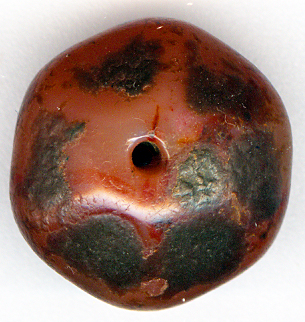
RB 8
-
18 * 13 mm -
Hexagon
Super ancient
Proto Elamite carnelian bead -
'polished' and charged with spiritual DNA since the beginning of the bronze
age.
|
A human polishing process stretching over generations
The process of human polishing is not an
event but an epoch. One lifetime of wear isn't sufficient to imbue the
bead with the characteristic, almost skin-like shine of generations of
touch. This transformation takes several generations of contact, wear,
and polishing before a bead can fully mature in its aesthetic appeal.
Pause for a moment, and behold the bead displayed above. Its journey
across generations and lives is evident in its sheen - it is as if beads
themselves believe in the concept of reincarnation.
Below, you will observe a
breathtaking ancient banded agate bead. Generations of contact have
softened its surface, imparting a patina that is nothing short of a
royal seal of antiquity. This soft sheen cannot be faked, nor can it be
hastily acquired. Note also the edges of the small crack on the right
side of the bead - such signs are trustworthy indicators of authentic
age in a stone bead. Similar to how continuous waves polish stones on
the seashore, the unending encounter of human skin and bead polishes the
bead over time.
In India, there exist sacred fireplaces where the duty of keeping the
flame alive has been passed down from guru to student across countless
generations. Drawing a parallel, it is not far-fetched, especially when
considering the timeless continuity of India, to imagine that there
exist stone beads that have been in constant contact with human skin
since the dawn of civilization!
|
|
|
|
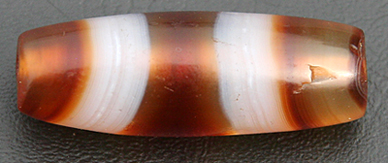
Ancient bead
worn for several generations
|
|
This revelation positions beads not merely as the oldest
form of art, but also as the most persistent and
unchanging art form in the annals of human history.
Consider this - the stone bead you see below, worn by me
in the present, could very well have adorned the neck of
a Neolithic individual some 8000 years ago. Such
continuity, such survival of beauty and significance
through thousands of years, is nothing short of
awe-inspiring. It's a testament to the enduring human
spirit and the timeless allure of personal adornment,
making beads a physical embodiment of our collective
human story. If this doesn't inspire awe, it's hard to
imagine what will.
|
|
|
|
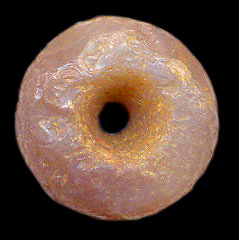
Neolithic bead
|
Indeed, the contrast can be stark. The Luk Mik bead
pictured below has a decidedly new sheen. While it may
be difficult to discern in a web photograph, there's a
distinct difference that becomes evident upon closer
examination. The surface of the bead gleams brightly,
untouched by the gentle abrasion of human skin and the
wear of time. It acts almost like a mirror, reflecting
light directly rather than softly diffusing it.
|
|
|
|
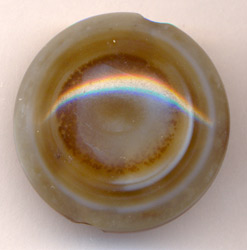
New
Luk Mik bead
|
|
This is a stark contrast to the other bead displayed
earlier. The older, ancient beads have a subtle, soft
reflection that comes from years of interaction with the
world and their wearers. They do not shine with the
stark, mirror-like quality of the newer beads.
This difference in shine is one of the key aspects used
to distinguish between new and ancient beads. Through
comparison, one can see how the mirror-like reflection
of the newer beads contrasts with the softer, diffused
glow of the ancient ones, a testimony to their
respective histories.
|
|
|
|
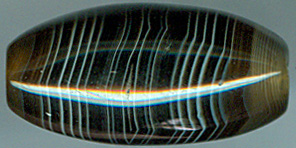
New bead
|
Indeed, the distinction
in the quality of reflection between ancient and new beads is
significant. Ancient beads have a more subdued glow; their surface,
polished by time and human touch, diffuses light rather than reflecting
it directly. This results in a gentler, warmer, and arguably more
profound sheen, bearing testament to their age and history.
In contrast, new beads, untouched by time and wear, have a sharper,
mirror-like reflection. Their surfaces are pristine and undisturbed,
which allows them to reflect light directly, creating a bright and
eye-catching shine.
This difference in reflection quality is one of the most reliable ways
to distinguish between ancient and new beads.
|
|
|
|

Ancient bead, worn by generations of human beings
|
Indeed, some dishonest dealers or artisans may attempt
to simulate the natural patina of an ancient bead
through artificial means to deceive buyers or
collectors. Sand-polishing is one such technique.
During the sand-polishing process, beads are placed in a
drum with sand and then tumbled for an extended period.
This abrasive action can wear down the bead's surface
and create a soft shine, mimicking the patina that
develops naturally over centuries of human contact.
However, while this method may produce a superficially
similar appearance, it generally can't replicate the
depth and subtlety of the patina found on genuinely
ancient beads. This artificial patina often lacks the
unique character and unevenness that result from the
countless human interactions ancient beads have endured.
Furthermore, sand-polished beads may exhibit tiny,
uniformly distributed scratches under a microscope, a
sign that is typically absent in genuine ancient beads.
The practice of artificially aging beads is considered
unethical in many circles, especially when done with the
intent to deceive. As such, collectors and enthusiasts
are encouraged to scrutinize beads closely, ideally with
the help of a magnifying glass or microscope, to detect
any signs of artificial aging. It's also crucial to
purchase from reputable sources to avoid inadvertently
buying artificially aged or counterfeit beads.
|
|
|
|
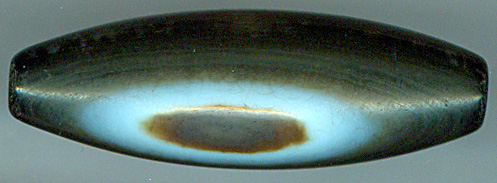
Fake
bead
|
It is quite obvious that the bead above is a fake. Even this
photo can show it.
However,
counterfeit or imitation ancient beads can be quite convincing, and this
has become an increasing challenge for both collectors and experts
alike. Advances in technology and craftsmanship have made it possible to
create fakes that are very similar in appearance to their authentic
counterparts.
THE SWEAT OF HUMAN EFFORT
We now shift our focus to
the intricate process of stone bead creation. In the
early stages of bead making, bead production was a
laborious, time-consuming task. Consequently, a finely
crafted bead was a rarity and often reserved for the
elite strata of society. But with the advent of new bead
production technologies such as the polishing bag and
diamond drill, stone beads became more commonplace. They
embarked on a societal journey, transitioning from
exclusive symbols of the upper echelons to more
widespread adornments, finally finding their place
within the poorer communities. Today, the age-old
tradition of stone bead making and the search for raw
agate is upheld by the Bhils (or Bheels), using the
simplest of tools.
The Bhils are indigenous to India, known as the largest
tribal community in the country. Revered by Gandhi as
the Adivasis, or the 'original inhabitants', they
represent the primordial roots of the region.
The Bhils' ancestry can be traced back to the original
Indus Valley civilization, pre-dating the Vedic-Aryan
settlement. One might argue that the Bhils and their
beads embarked on a social detour, transitioning from
the splendor of one of the world's most affluent and
enigmatic ancient cultures to their current position as
outcasts, marginalized and stigmatized by their newer
Vedic overlords. As alluded to elsewhere on
ancientbead.com, there is likely a
connection between
the Buddhist affinity for stone beads and the
similar sentiment shared by the earlier Indus
civilization.
THE DIVERSITY OF MATERIALS UTILIZED IN BEAD MANUFACTURE
Beads have historically been fashioned from a wide variety of materials,
including glass, bone, ivory, wood, and even seeds such as the revered
Rudraksha.
Metals like gold, silver, and bronze have also been used to create
beads. Their intrinsic value, malleability, and luster have made them a
preferred choice for creating high-status and ceremonial beads.
Lastly, ceramics and clay have been used extensively for bead-making due
to their availability and versatility. From simple fired clay beads to
intricately decorated ceramic beads, these materials provided an easily
accessible medium for bead artisans throughout history.
Beads made out of stone
Nevertheless, the primary focus at Ancientbead.com lies with stone
beads.
During the ancient era of the Indus Valley civilization, bead artisans
pursued extraordinary lengths to obtain unique and unusual stone
materials. As a result, we encounter numerous
beads crafted from fossilized stones
hailing from this period.
Since the Indus period the range of stones used in bead creation has
been remarkably broad, and their classification can often seem
perplexing and inconsistent. The subjective lens through which a
geologist, mineralogist, gemologist, and archaeologist view and
interpret a specific stone type can vary significantly, underscoring the
inherent complexity and ambiguity present in this field.
Microcrystalline Silicates
Nonetheless, agate, chalcedony, carnelian, chert, flint,
jasper, chrysoprase, sard, and onyx collectively
constitute a category of closely related, yet remarkably
diverse, sedimentary rocks known as microcrystalline
silicates. These materials are predominantly composed of
microscopic quartz crystals formed by the chemical
precipitation of silica from an aqueous solution.
Despite their mineralogical similarity, microcrystalline
silicates exhibit a high degree of visual diversity that
resists easy or definitive classification. They range
from entirely opaque to semi-translucent, may exhibit a
monochromatic or variegated palette, and can display an
array of unique patterns and banding. Thus, this
fascinating group of stones offers a virtually limitless
selection of textures and hues, providing ample creative
fodder for the discerning bead crafter.
DIAPHANEITY:
Light Interaction with Minerals
One key characteristic of minerals that's particularly
important in bead making and gemology is diaphaneity.
This term describes the way light interacts with a
mineral's surface and passes through it.
Transparent: If light can pass through a
substance undisturbed, without any distortion, the
substance is considered to be transparent. This quality
allows you to clearly see through the mineral. Gemstones
like diamond, amethyst, and quartz are examples of
transparent minerals.
Translucent: If light is able to pass through a
substance, but in a distorted or diffused manner, such
that objects cannot be clearly discerned through it, the
substance is considered to be translucent. Many types of
agate and some forms of jade and carnelian are typically
translucent.
Opaque: If light cannot pass through a substance
at all, it is classified as opaque. These materials
absorb or reflect all light that strikes them, and no
light passes through them. Examples of opaque minerals
commonly used in bead making include lapis lazuli,
turquoise, and most types of jasper.
The degree of diaphaneity can greatly affect the
appearance and aesthetic appeal of a bead or gemstone,
influencing factors such as color intensity, depth, and
perceived 'glow' or 'fire' within the stone. Thus,
understanding diaphaneity is crucial for both
gemologists and bead artisans.
MINING AND COLLECTING
OF RAW MATERIAL
The sourcing of raw materials for bead making is a
critical step in the process, and traditionally the
ideal location for a bead manufacturing site would be
one with easy access to these materials as well as a
nearby market for selling the finished products.
Historically, Gujarat in India has been a major hub for
this activity, providing abundant access to high-quality
materials ideal for bead creation.
The ancient mines of Baba Ghori in Ratanpur, Gujarat are
a notable example. These mines are dug 30 to 35 feet
deep until the layers of carnelian or agate are reached.
The blocks of stone that are mined, weighing one to two
pounds, are brought to the surface and chipped right at
the mining site. From there the stone are transported to
the nearby city, Cambey.
However, the ancient history of bead making did not origin in Cambey. It
began in the nearby ancient site Harappan,
Lothal.
Interestingly, in Lothal
we find the world's earliest known dock, which connected the city to the
Sabarmati river. Seen in this context it gives meaning that we find
Indus beads as far away
as Troy.
Even today, the
Bheel community continues the tradition
of 'hunting' for stones in the major mines of Gujarat.
These mining locations and the traditions associated
with them date back to the times of the Indus Valley
civilization, making them several thousand years old!
Outside Gujarat
We must not forget that there there were (and are) a number of other
locations where minerals suitable for bead-making were procured.
Afghanistan, in particular, is a country rich in mineral resources, many
of which were historically used for bead production.
Lapis Lazuli: Perhaps the most famous mineral exported from Afghanistan
for bead-making is lapis lazuli. This vibrant blue stone has been prized
for thousands of years and was a key part of the ancient trade networks
extending as far west as Egypt and as far east as India. The
Sar-e-Sang
mine in Afghanistan's Badakhshan province has been a primary source of
lapis lazuli for millennia.
Carnelian: This semi-precious gemstone, also known as cornelian, is a
reddish variety of chalcedony that's been used for bead-making for
thousands of years. It was often sourced from the regions that are now
Afghanistan and Pakistan.
Other Gemstones: Afghanistan is also known for its deposits of emeralds,
rubies, garnets, and other precious and semi-precious stones, all of
which have been used in jewelry and bead-making.
We also have to mention the other important bead procurement places
along the silk route in ancient times.
Egypt: Egypt is home to several ancient mines and quarries. Malachite
and turquoise were extracted in the Sinai Peninsula, and carnelian was
sourced from the Eastern Desert.
Mesopotamia (Present-day Iraq): The ancient civilizations in this
region, like the Sumerians and Akkadians, traded for carnelian, lapis
lazuli, and other semi-precious stones for bead-making.
Persia (Present-day Iran): Ancient Persia was a rich source of
turquoise, a stone that has been used for millennia in jewelry and
bead-making.
Greece: The island of Crete in Greece was renowned for its gold, silver,
and lapis lazuli, which were used in the creation of Minoan beads.
Minoan seals are among the finest ever made.
Historically, expansive trade networks such as the Silk Road connected
disparate regions, facilitating the exchange of diverse goods including
raw materials, finished beads, and other commodities. For instance,
beads crafted in Afghanistan could incorporate materials sourced from
far-off lands, and conversely, Afghan materials could be found in beads
produced elsewhere. In this way beads were travelling, even before
they became beads.
Methods for
Obtaining Raw Materials
Finding the perfect stone for bead making isn't easy.
These mining sites often contain a significant amount of
debris, including flakes of stone and stones that have
cracked in unfavorable ways. These discarded materials
form a sort of 'bead junkyard' that can be thousands of
years old. However, nothing is wasted; smaller beads can
often be made from these discarded pieces, recycling
what might have been seen as waste into valuable
products. This practice of reusing and repurposing
materials is not a modern invention, but an ancient
tradition that has been carried forward into the present
day.
There have been various techniques employed over the
ages to source stones for bead-making. One of the most
common was to look for them in eroding cliffs or rocky
outcrops. The action of wind and water often exposed
suitable stones, which could be readily collected.
Another method involved a more proactive approach. A
fire would be built near a cliff face, heating the stone
surface. Cold water would then be thrown onto the heated
cliff, causing the abrupt temperature change to induce
cracking and flaking in the stone surface. This could
effectively 'harvest' stone from the cliff in a
controlled manner.
Searching in river beds was yet another method. River
water, particularly in fast-flowing streams, has a
tendency to erode and polish stones, leading to the
natural production of semi-finished stones suitable for
bead-making.
Once the stones were collected, flakes were struck from
the nodules to assess the quality of the stone. The best
pieces of agate were then left in the sun for a period
of time - often several months - to draw out any
remaining moisture in the stone.
Following this natural drying process, selected stones
were subjected to further artificial heat treatments. As
discussed in the
Sulemani bead chapter, different
heating techniques
were used to produce different types of beads. The first
heat treatment after sun drying was usually carried out
in terracotta vessels or simple pit kilns and was aimed
at removing any residual moisture. This process made it
easier to flake the stones, as moisture within the
stones could lead to unpredictable flaking patterns.
|
|
|
|
|
|


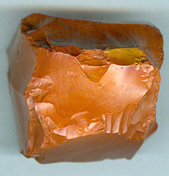 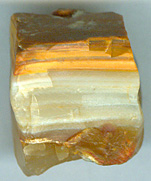
|
Unearthed at
archaeological sites, these rough-outs share striking
similarities with those we might find today in the
bustling bead industry of Cambay, located in Gujarat,
India. Their shape and markings point towards the
ancient practice of hand-sawing and chipping raw stones
into shape. The traditional method, termed inverse,
indirect percussion (Kenoyer, 1986), was a meticulous
art passed down through generations.
This labor-intensive technique required a stake, usually
made from iron or other sturdy materials, to be firmly
planted into the ground at an angle of approximately 45
degrees. The artisan would position himself on the
ground, steadying the stake with one knee. The rough
stone was held in the left hand while the right hand was
tasked with gently hitting the stone against the stake.
This careful percussion allowed the artisan to chip off
minute flakes without fracturing the entire stone,
requiring around 3 to 4 hours of painstaking effort to
shape a single bead.
Before the advent of iron tools, copper was commonly
used for the stake, and even earlier, deer antlers may
have served the same purpose. The distinctive signs of
flaking resulting from this shaping process are easily
identifiable and unique to handcrafted beads.
Today, while some aspects of this age-old craft persist,
many elements have undergone a shift in response to
technological advancements. Most notably, the cutting of
stones is frequently performed using electric-powered
saws, a far cry from the hand tools of yesteryears.
DESIGN
& SHAPE
The
design and form of ancient stone beads often seem to
have been influenced by the inherent patterns and
characteristics of the raw material itself. This
suggests that even at the stage of mining, the workers
were on the lookout for distinct stone patterns that
could eventually serve as a central motif in an
exceptional bead. As a result, the natural beauty of the
stone patterns was recognized and celebrated by their
makers from the very outset of the process.
The Pursuit for the Exceptional Bead Amidst Urban
Expansion
During ancient times, particularly amongst the Indus
Valley civilizations, artisans went to great lengths to
procure exotic stones to create beads of varying colors,
shapes, and sizes. This effort escalated towards the end
of the Indus culture and the beginning of the Classical
period, around the first millennium B.C., coinciding
with India's Urban Revolution on the Gangetic Plains.
This transformative era ushered in a demand for
distinctive beads that could act as artistic reflections
of the burgeoning self-consciousness accompanying city
life. As society transitioned from pastoral and agrarian
ways to a more urbanized lifestyle, the representation
of status, power, and individuality through personal
adornments became more significant.
During this period, bead making came under the patronage
of kings, priests, and merchants, causing it to flourish
amidst a rich cultural tapestry of patterns, colors, and
exotic materials. The bead, thus, not only served as a
simple decorative object but also a symbol of
socio-cultural evolution, mirroring the changing
dynamics of society.
The outstanding bead displayed below
from Rakhigarhi is an example of this hunt for the urban exotic
and rare:
|
|
|
|
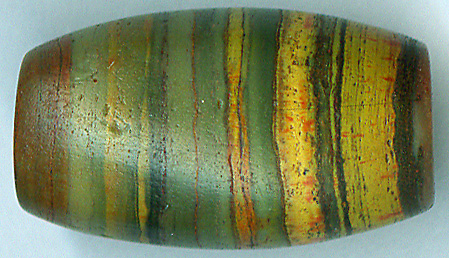
|
Beads are indeed
crafted in a wide array of shapes, largely constrained
by the available technology and the characteristics of
the raw material. At one end of the spectrum, we find
beads that are essentially naturally occurring stones
that have been smoothed through tumbling and
subsequently pierced to create a hole:
|
|
|
|
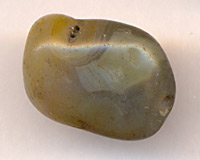
|
Exceptional beads often demonstrate a high degree of
artistic intelligence and skill in their creation, as is
evident in the magnificent crystal tiger bead depicted
below:
|
|
|
|
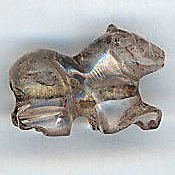
|
This bead stands as a testament to the craftsman's
expertise and artistic vision. It demonstrates not only
a mastery of technical skills but also a deep
understanding of aesthetics, symmetry, and design.
The process of crafting such a bead involves more than
just selecting the right stone. It requires meticulous
planning, precise execution, and a keen eye for detail.
The artisan has to understand the inherent properties
and limitations of the material, envision the final
product, and carefully manipulate the stone to bring
that vision to life.
The finished bead is a perfect harmony of form, color,
and texture, revealing both the natural beauty of the
crystal and the masterful artistry of its creator. Such
exceptional pieces transcend their utilitarian purpose
as beads and enter the realm of fine art.
In very rare cases the artisans were composing beads through the process of cementing different types of stones with different patterns together:
|
|
|
|
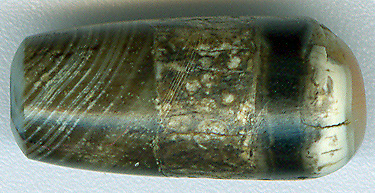
15 * 6,5 mm
Click on picture for larger version
|
The bead showcased below is an
example of a counterfeit bead I came across during my time in Burma as a
tour guide. Local villagers would bring these types of beads to sell to
unsuspecting tourists. Intriguingly, it is a composite piece, glued
together from various parts. Notably, only the carnelian segments are
derived from original ancient beads that were broken. I somehow still
adore this semi-original bead and believe it was worth every penny I
paid for it.
|
|
|
|

|
How to
liberate the dormant beauty in a stone
As previously mentioned, the inherent pattern or motif within a stone
often dictates the form the bead will take, and in turn, this form
accentuates the motif. A keen eye for aesthetics, understanding of
symmetry, and careful consideration of the stone's natural patterns are
essential in this process.
|
|
|
|
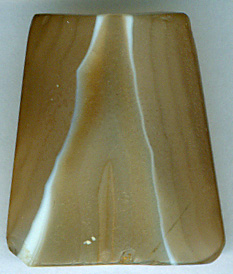 
21 * 19 * 13 * 6 mm
|
Take, for
instance, the
Indus Valley bead displayed above. Notice how the
symmetry inherent in the stone has guided the crafting
of the bead. The artisan, working with the natural
design rather than against it, has highlighted and
emphasized its inherent beauty. This interplay between
nature's artwork and human craftsmanship is what
elevates these beads from simple ornaments to true works
of art.
Consider the small bead displayed below. In it, we see a
prime example of this synergy between the natural beauty
of the stone and the artisan's handiwork. The artisan
has not merely shaped the stone but has unleashed its
dormant aesthetic potential, allowing it to reveal its
true beauty to the world. Its an organic process,
almost as if the stone and artisan are in conversation,
ultimately resulting in a piece of art that is as much a
testament to the nature of the material as it is to the
skill of the bead-maker.
|
|
|
|
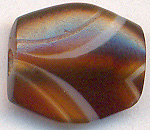
11 * 10 * 3 mm
|
The Golden Angle
in Motifs: A Case Study from the Indus Valley
The golden
angle is a
mathematical concept found frequently in nature and used widely in art
and design. This angle, approximately 137.5 degrees, is derived from the
golden ratio, a mathematical constant found in many aspects of life,
from the spiraling pattern of a nautilus shell to the branching of
trees.
This principle extends to bead-making as well. In many ancient bead
designs, the golden angle can be found. A fine example of this can be
seen in the Indus Valley bead illustrated below.
|
|
|
|
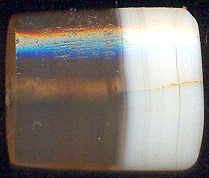
17 * 14 * 4 mm
|
Observe the
motifs and how they reflect this golden angle. The
artisan behind this bead, consciously or subconsciously,
has used the principles of sacred geometry to create a
design that is visually harmonious and balanced. This
adherence to the golden angle, whether intentional or
not, gives the bead a timeless aesthetic quality,
connecting it to the universal patterns found in nature
and art.
In the
Magic Eye
Bead below the eye is placed in the symmetric
middle:
|
|
|
|
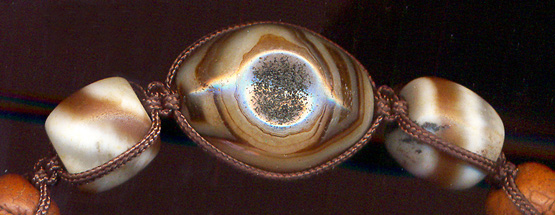
28 * 19 mm
|
Or it can be placed in the golden angle position:
|
|
|
|
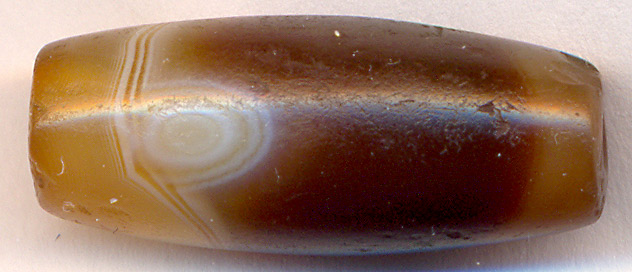
24 * 10 mm
|
|
Adopting Human Body Forms in Bead Design: An Exemplar
Agate Bead
The fusion of art, utility, and anthropology is an intrinsic
part of bead making, where artisans have traditionally kept in
mind not just the aesthetic appeal but also the comfort and fit
of the bead when worn. One such outstanding illustration of this
thoughtful craftsmanship is seen in the long agate bead
displayed below, crafted with a specific consideration for the
wearer's body shape.
|
|
|
|

83 * 12 * 8 mm
|
This agate bead is expertly shaped and polished to
feature a flat, bow-like side. This unique design allows
the bead to comfortably contour to the curves of the
human body when worn. This kind of thoughtful design is
part of what makes ancient beads so fascinating. The
artisan who crafted this piece centuries ago was not
merely creating an adornment, but a piece of wearable
art designed with the wearer's comfort in mind.
ARCHETYPICAL
BEAD SHAPES
Below you will find
illustrations of a few of the most typical bead forms.
|
|
|
|
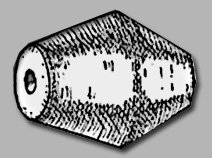
Bicone
|
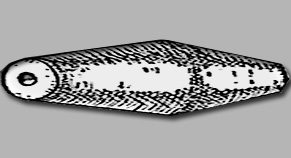
Long Bicone
|
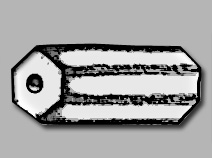
Hexagonal Tube |
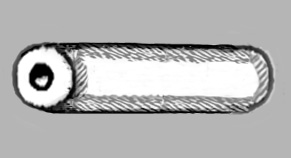
Round Tube
|

Barrel |

Collar |
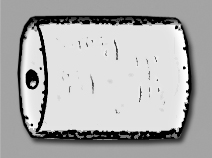
Cylinder /
Lenticular |
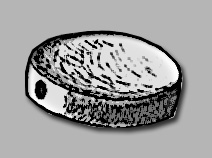
Round tabular |

Mellon
|

Ball
|
Here you will find more detailed illustrations of bead forms
borrowed from the book, The beads from Taxila, by Horace Beck
|
|
|
|
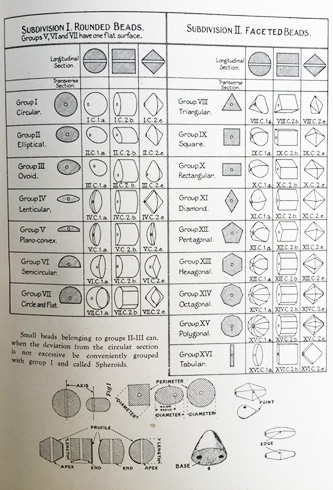
Click on
pictures for larger versions
|
|
|
|
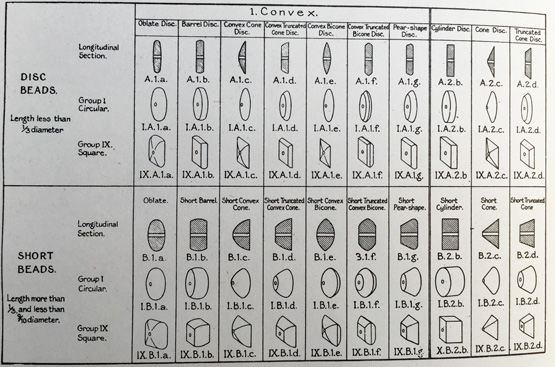
|
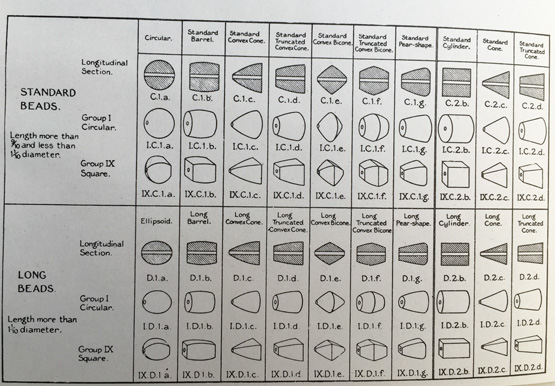 |
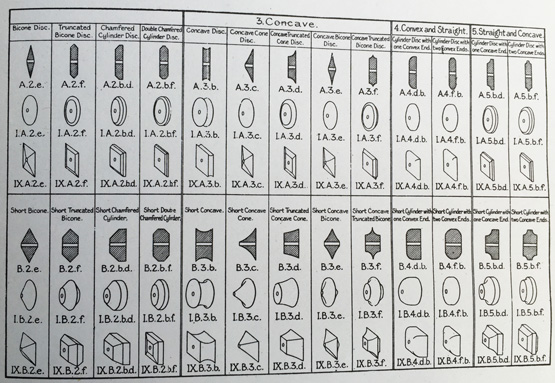
|
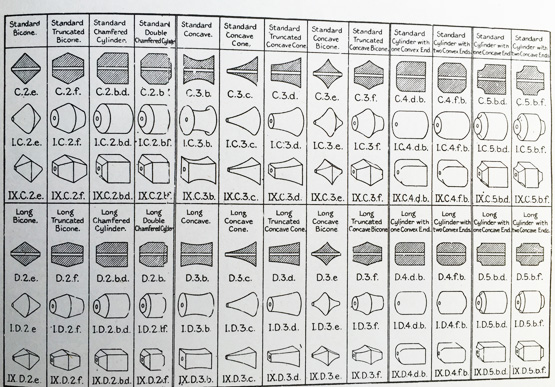
|
Click on
pictures for larger versions
|
THE
GRINDING & POLISHING PROCESS
Crafting beads is a
multifaceted process, with distinct stages of
development entrusted to specific artisans. The miners
who unearthed the raw agate from the ground were
different from those who chipped and rough-shaped the
beads, who were in turn distinct from those responsible
for the final grinding and polishing.
|
|
|
|
Hand grinding of beads
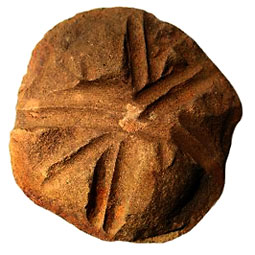
Neolithic hand grinding stone
|
Historically, many
beads were prone to breakage during the complex
drilling process.
As such, the bead's polishing was often reserved until after a
successful drilling operation.
In ancient times, this polishing process was laboriously conducted by
hand. It involved a succession of different grinders, starting with
siltstone or quartzite for the initial rough polishing and culminating
with a smooth wooden surface for the final finish. The artisans used
progressively finer abrasives - like agate dust or other suitable
materials - to bring the bead to its final form.
This meticulous hand-polishing could take an extraordinary amount of
time. For instance, grinding a single large bead could take up to five
days in ancient times. Today, with the aid of modern machinery, the same
process can be accomplished in a mere five minutes.
Interestingly, the surface texture of a bead can reveal insights into
the polishing techniques used. For instance, the uneven surface of the Indus Valley bead
pictured above indicates a polishing technique that used very rough
abrasives. This evidence of the artisan's hand, preserved in the bead's
surface, adds another layer of depth to its history and appeal.
|
|
|
|

21 * 8 * 6,5 mm
|
ROCK POLISHING TECHNIQUES IN
ANTIQUITY
In ancient Egypt, the art of
rock polishing was painstakingly performed by slaves. Stones, carefully
chosen for their qualities, were manually chipped into initial shapes.
The subsequent process involved placing these stones into troughs filled
with a combination of sand and water. Through a repetitive
back-and-forth movement in these troughs, the stones gradually became
smoother, eventually achieving a polished finish. This "tumbling"
technique, albeit effective, was extremely time-consuming. It was not
uncommon for the polishing of a single stone to span several months.
Bag Polishing - Revolution of Tumbling in Ancient India
A remarkable advancement in bead polishing was introduced in ancient
India with the development of a new technique known as tumbling, also
referred to as bag polishing. Prior to this innovation, each bead was
individually shaped and polished, either by hand-rubbing or employing a
somewhat mysterious Persian method.
The advent of bag polishing allowed for the simultaneous polishing of
multiple beads. Artisans would place a number of beads into a goatskin
bag, along with water and dust from agate or jasper. Then, two
individuals would roll the bag back and forth on the ground over a
course of several days, even weeks. The resulting movement and the
abrasiveness of the dust within the bag effectively polished the beads.
|
|
|
|
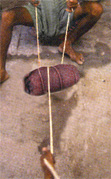
|
|
This ingenious tumbling method, in conjunction with the
second-century BC invention of the diamond drill, laid
the foundation for the mass production of beads.
However, the shift towards efficiency in mass production
often came at the cost of individual craftsmanship and
personal touch. The societal, economic, and
technological changes of the time were reflected in this
transition to bag polishing.
The precise origins of the bag polishing technique for
stone beads remain a subject of speculation. It is
believed to have likely been developed during the late
first millennium BCE, with its usage becoming more
widespread during the early Common Era, in line with the
emergence of large-scale bead production.
These timelines, however, are largely drawn from
archaeological evidence and historical contexts, and may
vary across different regions or cultures. It's also
worth noting that different civilizations may have
independently developed similar techniques at varying
times.
Technological advancements, like bag polishing, rarely
occur as singular "eureka" moments. Instead, they
typically evolve and improve over time. Techniques like
bag polishing would have likely undergone numerous
refinements and adaptations over generations, gaining
popularity as their effectiveness was proven.
|
|
|
|
 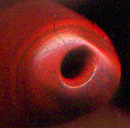
55 * 13 mm
|
The large red Jasper bead
shown above, with its relatively large hole, appears to
originate from the Indus period, given its similarities
to beads from early Indus sites in present-day
Baluchistan. Interestingly, the bead exhibits evidence
of having been polished in a tumbler, suggesting that
the technique of bag polishing might have been known
even during the time of the Indus civilization.
In this particular instance, the bead maker appears to
have let the tumbling process dictate the shape of the
bead. The uneven design and lack of deliberate artistic
shaping suggest minimal manual intervention, which could
indicate a rudimentary level of craftsmanship. This
might hint at a dual-tier bead-making industry during
the Indus period: one that utilized bag polishing to
mass-produce simpler, lower-cost beads for the lower
classes, and another that used more labor-intensive
hand-polishing techniques to create high-quality beads
for the upper echelons of society.
|
|
|
|
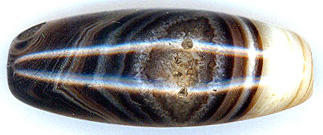
|
The bead shown above
exhibits a characteristic 'tumbled design'. Notice the
gentle curves and soft corners of the bead; these are
distinctive traits resulting from bag polishing. This
method, while efficient for mass production, tends to
limit the variety of bead forms that can be achieved.
Thus, the cost of mass production is often a degree of
monotony and uniformity in bead shapes.
In contrast, the bead displayed below has not undergone
the tumbling process. It has sharper edges and likely
reflects a more intricate and personalized crafting
process. Its design and form represent the wider range
of possibilities that come with handcrafted techniques,
highlighting the unique character inherent in
individually made pieces.
|
|
|
|
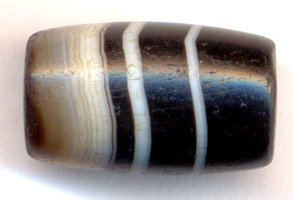
17 * 11 mm
|
The time-consuming process of hand rubbing the beads had one advantage that was lost with the bag polishing: The hand shaped beads can display edges and sharp designs like you can see in the beads displayed below:
|
|
|
|
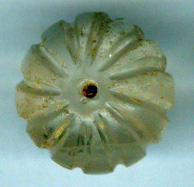
12 * 11 mm
|
|
The same is the case with Zoomorphic, human and other distinctive designed beads; they would lose their shape in a tumbler.
|
|
|
|
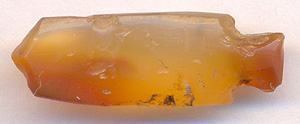
23 * 8 * 4 mm
Ancient carnelian roman/greek sword bead
|
Of course, the hand-polishing of beads did not disappear. However, the hand-polished beads got great competition from the mass producing 'new' tumble technique.
Here you can see a multi-faceted carnelian bead from the British period:
|
|
|
|
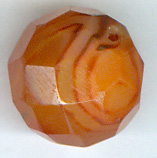
11 mm
|
The sublime Mauryan bead
polishing
The
Mauryan period marked an unprecedented pinnacle in
bead polishing, wherein artisans seemed to apply
extraordinary, now lost, techniques that paralleled
those used on Mauryan pottery and monuments. This
supposition, while still a hypothesis, is based on the
remarkably fine finish observed on Mauryan beads, as
exemplified by the one shown below.
|
|
|
|

Banded
Buddha
|
The Mauryan polish on agate and carnelian beads is
perhaps unrivaled in any other period in history. We
have no independent evidence as to how this polish was
imparted on the beads, but it probably was not far from
the one used in polishing the famous pillars on which
the edicts (of Ashoka) were carved...
(Indian Beads - Shantaram B. Deo p.14)
|
|
|
|
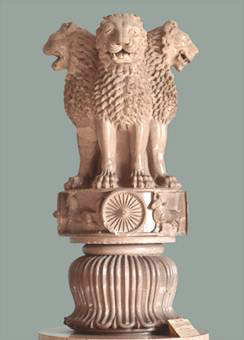
Ashoka's four lions - Museum in Sarnath
These Ashoka Lions were erected on 15 meter
tall pillars everywhere in Ashoka's vast Empire.
|
Today, it is widely believed that the exquisite
sandstone lions exhibited above were most likely crafted
by Persian artisans. Their style, as noted in the
museum's text, appears distinctively Persian. The unique
polishing technique displayed also seems to be of
Persian origin. The Mauryan capital,
Pataliputra, appears to have emulated Persepolis,
the ceremonial capital of the Achaemenid Empire in
Persia.
It's conceivable that the rise of the Mauryan Empire was
underpinned by alliances formed between residual Persian
military units left in disarray after Alexander the
Great's conquest and subsequent destruction of the
Persian Empire and insurgent factions within Indian
society. Notably,
Chandragupta Maurya, the founder of the Mauryan
Empire, was a person of lower caste who forged a
powerful alliance with the renowned Brahmin scholar,
Chanakya.
In this light, the emergence of the first super culture
following the decline of the expansive Indus
Civilization appears to have been sparked by the
remnants of cultural destruction left by Alexander the
Great's conquests. The Mauryan Empire, it seems, was
built upon the cultural rubble of Persia, amalgamating
the finest elements of both Persian and Indian cultures
to form a dynamic synthesis.
This historical conjecture becomes particularly
intriguing in the context of bead-making, given the
convergence of Persian's supreme (and now lost)
polishing techniques with India's established
bead-making traditions. The result was an extraordinary
blend of craftsmanship that echoed the cultural synergy
of the era.
HEAT TREATMENT IN BEAD MAKING
The enigmatic Indus Valley civilization deserves
commendation for their innovative techniques in
enhancing the color of agate through heat treatment
techniques still employed today in Cambay, Gujarat. This
heating process is done in multiple stages, following
the initial drying and heating processes described in
the 'Mining and Collecting of Raw Material' chapter. It
typically takes place after the bead has been roughly
shaped and the hole has been drilled.
In this process, beads are sorted based on design,
color, and potential color changes, and are then placed
into various clay pots. These pots are then positioned
within small, low-walled brick enclosures. Surrounding
the pots, a combination of ashes and cow or goat dung is
carefully layered. Simultaneous ignition is crucial to
prevent thermal shock.
The agate is gradually heated to a temperature around
340 degrees Celsius, with cooling also conducted slowly
to prevent unwanted cracks in the stones. Even so, the
process is not foolproof, and unwanted cracks can still
occur during a perfectly executed heating process.
This procedure, therefore, requires the supervision of a
highly skilled craftsman, trained in this craft by his
father, often part of an unbroken generational chain
stretching back to ancient times. It is no surprise that
father's name is an essential detail in an Indian visa
application, symbolizing the cultural importance of
lineage and continuity. The intricate art of bead
making, handed down through generations, is a testament
to the enduring brilliance of these ancient practices.
Distinguishing Between
Cooked or uncooked agate beads
When it comes to agate
bead treatment, not all stones undergo the heating
process. After extraction, the agate is typically
separated into two categories: stones that would benefit
from heat treatment for color enhancement, and those
that naturally display a beautiful, translucent shine
without the need for heating.
For the latter group, their intrinsic allure is left
untouched, allowing the original hues and features of
the agate to shine through in the final product. An
example of this 'uncooked' bead can be seen below. Such
agate beads, that are not subject to heat treatment, are
often referred to as 'uncooked,' preserving their raw,
authentic beauty.
|
|
|
|
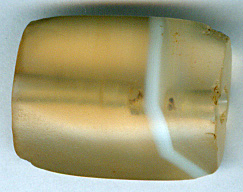 
17 * 14 * 6 mm
|
Heat Transformatin:
From agate to carnelian
A particularly remarkable
feature of certain agate stones, specifically those
originating from Cambay in India, is their capacity to
transform into carnelian under the influence of heat.
The characteristic reddish-orange color of Carnelian, a
prized attribute of this semiprecious stone, can be seen
in the example below:
|
|
|
|

Cambey carnelian
|
|
The transformation of the grayish agate to the radiant
carnelian is largely due to the high iron oxide content
within the stone. When subjected to heat, the rusty iron
oxide imparts a warm, reddish hue to the agate.
The uniformity of the resulting coloration depends on
the consistency of porosity and iron concentration
within the agate. Heat exposure transmutes the agate
into a beautifully rich brownish or reddish-orange
stone.
Agates with
relatively uniform porosity tend to exhibit consistent
coloration post-enhancement. Nonetheless, the color
uniformity of carnelian also relies on the consistent
concentration of iron throughout the stone. From
archaeological findings, it seems that the ancient Indus
people favored non-translucent, almost opaque
carnelian beads
with even coloring, similar to the bead seen here:
|
|
|
|
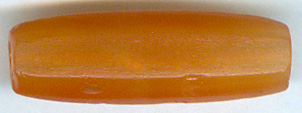
27 * 9 mm
|
Achieving the Ideal
Carnelian Color
The process of transforming agate into carnelian
often required multiple rounds of careful heating,
sometimes up to ten iterations, in order to achieve the
desired deep red color, which was considered top
quality. You can observe this rich hue in the carnelian
beads
displayed at this link.
The history of carnelian production
This invention of transforming gray agate into carnelian is
ancient. We can find heat treated carnelian as far back as the Neolithic period:
|
|
|
|
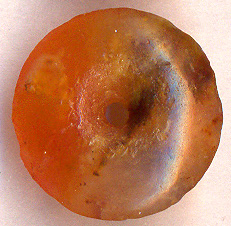
Neolithic disk bead from Sahara, Africa
|
Here in these very
Early Indus Valley beads we can observe a beautiful blood like
the color of carnelian:
|
|
|
|
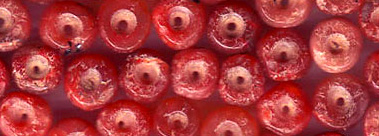
|
As we journey back in time,
the line between rational thinking and magic becomes
increasingly blurred. The significance of carnelian
beads to the Indus people remains largely unknown, but
historical texts from Mesopotamia, a civilization
contemporaneous to the Indus Valley, suggest a magical
aspect to these gemstones. The deep red color of
carnelian was believed to be associated with
purification of the blood and overall health, revealing
an early understanding of the concept of healing stones
and their potential metaphysical properties.
Understanding
Agate and Onyx
Agate is distinguished by
its irregular, curved bands of various colors, formed
layer by layer in volcanic rock. Onyx, another variety
of chalcedony like agate, has straight, parallel bands,
often in black, white, or shades of brown. These
distinct banding patterns are a result of their unique
geological formation processes.
|
|
|
|
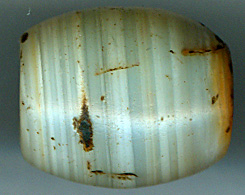 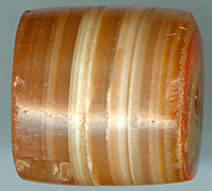
Fine
circular banded Onyx and Sardonyx versus agate:
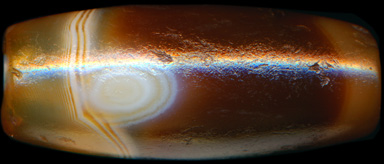
|
A particular variety of
onyx, characterized by its carnelian iron color banding, is
known as Sardonyx.
However, the nomenclature around various
microcrystalline
silicates can be somewhat confusing.
Sardonyx
originally referred to a specific stone found in
Sardinia. Today, however, agate that has been colored to
resemble carnelian and features fine circular banding is
often termed as Sardonyx.
Below you can enjoy two
stunning translucent sardonyx beads, or should we just
call it fine banded agate or onyx beads?
|
|
|
|

34 * 8 mm
Click on picture for larger version
|
|
|
|

25 * 6 mm
|
|
|
|
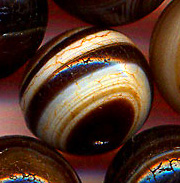
Bhaisayayguru sulemani bead
|
The intricate process that transforms an ordinary agate
into what is widely referred to as a
Sulemani agate bead
in India and the far East, likely dates back to over
four thousand years ago, credited to the inventive
prowess of the Indus Valley civilization. Naturally
occurring banded brown/black and white agate is quite
rare. Typically, agate in its unprocessed state exhibits
a whitish or grayish hue, as evident in the
'uncooked' Indus Valley bead
shown below:
|
|
|
|
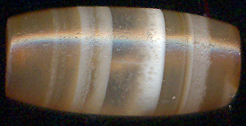
|
It's plausible that
this bead was
crafted before the advent of heat treatment for beads...
or perhaps the artisans simply preferred the
translucent, whitish glow of this stone. To achieve a
bead similar to the brown and white banded Bhaisayaguru
stone seen in the first picture, Indian craftspeople
started immersing the agate stone in oil, honey, or
sugar water. The sugar is absorbed more readily by the
darker and/or more porous layers, but not by the denser
white layers. During the heating process, the sugar
undergoes caramelization, turning the porous layers into
a deep black or rich brown, as can be observed in the
bead shown below:
|
|
|
|
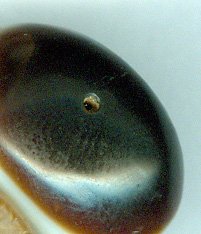
|
Nevertheless, every innovation carries a trade-off. The
transformation of agate into onyx often compromises the bead's
translucent sheen. Translucent beads with black stripes are a
rarity, possibly explaining why the artisans of the Indus Valley
chose not to treat certain beads, especially those with
captivating translucent bands and white stripes. An exemplary
bead of this kind can be observed below:
|
|
|
|
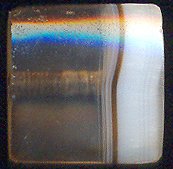
|
The alteration with
sulphoric acid
Over 2000 years ago, bead artisans refined their
techniques even further. They found that submerging a
sugar-soaked stone in sulphuric acid led to the
carbonization of the sugar, creating a striking black
hue instead of brown. Frequently, the artisans would
further augment this artificially enhanced banding
through a technique that deprived the stone of oxygen
during the heating process. The resulting onyx bead, a
magnificent opaque black agate, can be seen below. Also,
take note of the white banding visible in areas where
the stone's density prevents the chemicals from
permeating. These dense sections retain their natural
color, providing a stark contrast to the induced black
hues and adding a distinctive pattern to the bead.
|
|
|
|
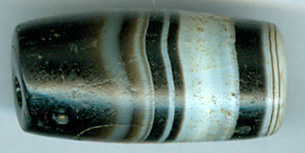
|
During this era, Buddhism was predominant in India.
Perhaps this is why the brown or black Sulemani onyx
bead remains the most coveted prayer bead for Buddhists
worldwide, even today. For more information on the heat
treatment process of beads, please refer to the
Sulemani Beads section.
THE ETCHING OF BEADS
The intricate design
adorning the ancient bead displayed below was
meticulously crafted using an alkali soda-based process
known as
etching. Etching is mostly done on carnelian
beads.
|
|
|
|
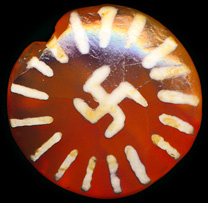
EB 1 - 12,5 * 4,9 mm
|
Etching on
carnelian beads is a fascinating process that involves
the careful manipulation of the stone's surface to
create intricate designs and patterns. While the exact
techniques may have varied among different cultures and
eras, the general principles of the process remain
consistent.
Preparation:
The bead begins as a rough piece of carnelian that has
been shaped into the desired form. Carnelian, a variety
of chalcedony, is chosen for its hardness, beautiful
color, and ability to hold intricate etched designs.
Design Mapping:
Once the bead has been shaped and smoothed, the artisan
outlines the design onto the bead using a sharp tool.
This stage requires precision and an understanding of
how the design will ultimately look on the rounded
surface of the bead.
Etching:
The outlined bead is then treated with a solution often
consisting of an alkaline soda. This could be a
naturally occurring substance, such as plant ash or
natron, which was used in ancient times. The solution is
applied only to the areas of the bead that are to be
etched. This solution selectively erodes the surface of
the carnelian, carving the design into the bead.
Heating:
The bead is then heated to intensify the color contrast
between the etched and unetched areas. The heat causes
the etched areas to turn white, while the rest of the
bead retains its rich carnelian color. This temperature
treatment also serves to enhance the durability of the
etching.
Polishing:
Finally, the bead is carefully polished. This can smooth
out any roughness from the etching process and adds a
beautiful shine, making the etched design stand out even
more.
|
|
|
|
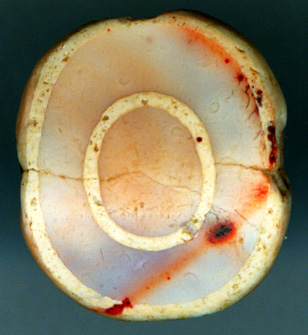
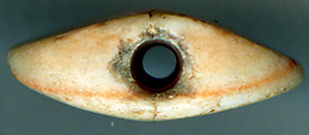
EB 1 - 13 * 11 * 5 mm
- Indus Valley etching
|
This unique decorative method has roots stretching back
to the Indus Valley and Harappan Civilizations around
2500 to 1500 BC. The Mauryan Period, under the
leadership of Chandragupta Maurya from 300 BC to 100 AD,
is recognized as the epoch when the craft of etching
beads reached its zenith in terms of quantity.
From 274 BC onward, India was under the benevolent reign
of Ashoka the Great, Chandragupta Maurya's grandson,
during which Buddhism became the predominant philosophy.
This historical context is crucial, as even today,
etched beads retain a special place in the hearts of
Buddhists around the world. Their historical and
spiritual significance, coupled with their aesthetic
appeal, ensures their enduring popularity.
|
|
|
|
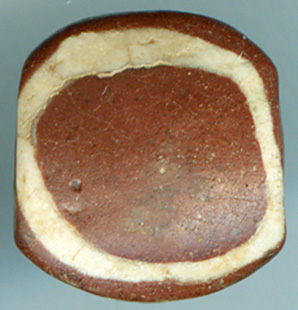
EB 3 -
12 * 4,5 mm
This bead is actually not etched,
but displays natural lines in
jasper stone.
|
|
|
|
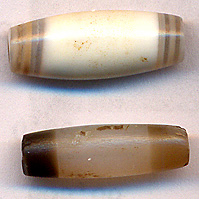
|
The image
above showcases an Indus Valley bead, remarkable in its
original, untouched pattern. Conversely, the bead
depicted below has been artificially colored to echo the
natural patterns found in its Indus predecessor. This
practice of etching beads emerged from a desire to
create visually stunning designs that might be otherwise
difficult or time-consuming to locate within the natural
patterns of the stones. Instead of painstakingly
searching for stones with inherent, appealing patterns,
artisans found a shortcut: enhancing the banding or
etching patterns directly onto the beads. This
innovative etching technology was birthed during the
Indus Valley era.
|
|
|
|


17 * 5 mm
|
Pictured above is a perfect and unique translucent
agate, showcasing natural banding from the Indus Valley
Civilization, dating back to 3000-1500 B.C. This
precious artifact was unearthed in 1942 in
Harappa,
now present-day Pakistan.
Upon comparing it with the etched bead depicted below,
it's striking to consider that the market value of this
etched 'replica' most probably surpasses that of the
original, un-etched Indus bead. I have personally no
doubt what bead I prefer!
|
|
|
|

|
However, the craft of
etching evolved beyond merely replicating natural
patterns. Over time, artisans began to create symbolic
and religious motifs, expressing intricate narratives
and meanings that surpassed the limitations of naturally
occurring stone patterns.
|
|
|
|
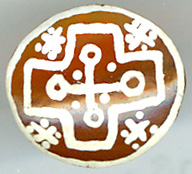
|
Even
in ancient times, these etched beads rose to the
pinnacle of popularity. They were traded extensively
across the ancient world. Frequently, the techniques of
color alteration and etching were combined, as
exemplified in the etched black spherical bead shown
below:
|
|
|
|
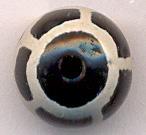
|
In rare cases we also find
etching with black lines.
|
|
|
|
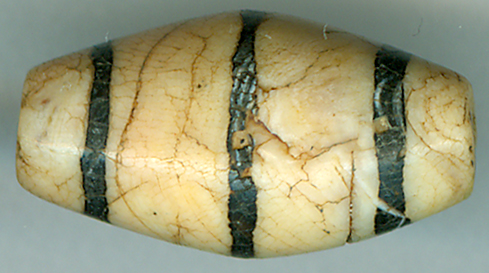
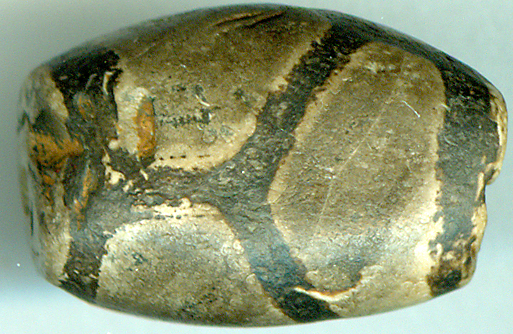
|
|
|
|
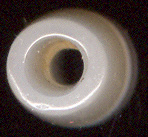
|
Drilling the hole in a bead is a pivotal
phase in the bead-making process and significantly aids
in its identification and classification. The drilling
process stands as a decisive 'make or break' moment,
considering the inherent risk of shattering the bead
during this delicate operation. Evidence of failed
attempts can be found scattered around ancient artisans'
workshops, testament to the challenges this task
presented.
Due to the potential catastrophe of ruining a fully
polished bead - a laborious effort possibly spanning a
month - the bead hole was drilled shortly after creating
the rough outline of the bead. This strategic sequence
minimized the risk of wasting significant time and
effort on a bead that would subsequently fracture during
drilling.
Creating the hole in a bead was a methodical process,
usually undertaken with careful consideration for the
bead's integrity. To prevent damaging the bead's ends or
'apices', holes were typically drilled from both sides,
as shown in the example below. This approach ensured a
cleaner finish and significantly reduced the chances of
causing a crack at either end of the bead.
HISTORY OF BEAD HOLE
CREATION
Neolithic Drilling Techniques
Incredibly, the production of
Neolithic beads was
accomplished with the simplest of tools! Displayed here
are drills used for pecking out the holes in these
ancient beads. The artisans employed a method of pecking
from both sides of the bead to create a hole.
|
|
|
|
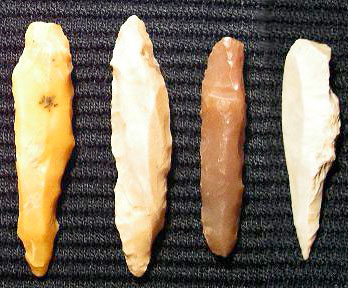
|
Interestingly, most
beads from the Neolithic period are not very elongated.
Given the size and shape of the drills shown above, it's
understandable that the beads were primarily of a
tabular form.
|
|
|
|
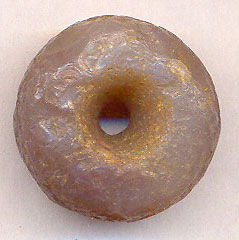
|
The process of
replicating the ancient Neolithic method of creating
bead holes is exceptionally challenging. This is
evidenced by the many broken beads found at
archeological sites, suggesting that bead hole creation
was a complex task even for the Neolithic people.
Indus Valley Bead Hole
Formation
A similar pecking method was used in the creation of
bead holes in the Indus Valley civilization, a tradition
which dates back to around 3000 BC. As shown in the
picture, the holes of these
early Indus Valley beads also reflect the pecking
technique.
|
|
|
|

|
Transition
to more elongated beads begins to be seen during the
early Indus Valley period, around 2500 BC. In the bicone
carnelian agate beads pictured below from this time
period, the beads have started to increase in length,
deviating from the previously dominant flat, tabular
design. This evolution in design led to a corresponding
increase in the complexity of the bead hole formation
process. The pecked holes in these elongated beads have
adopted a
rough hourglass shape, indicating the skill and
precision necessary to achieve this on a larger scale.
|
|
|
|
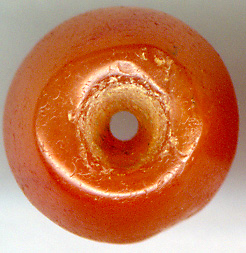
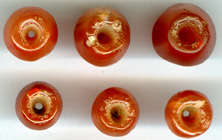
|
The Emergence of the Bow Drill - Facilitating the
Creation of Longer Beads and Holes
Following the early Indus Valley period, a significant
advancement in drilling technique emerged during the
Copper Bronze Age. This advancement was critical for
facilitating the creation of longer beads and bead
holes, a trend that had begun in West Asia and the Indus
Valley.
The bow drill, a technological marvel of its time, was
invented as far back as 4000 B.C. Remarkably, this tool
persists in modern times, especially in India, a
testament to its enduring utility and effectiveness.
At the beginning of the Bronze Age, around 3000 B.C.,
the material used for the drilling part of the tool
transitioned from
chert
to bronze. This transition resulted in more durable and
effective drilling tools. In Chanhu-Daru, an early Indus
Valley archaeological site, excavators discovered bronze
drills measuring approximately 4.8 cm in length (as
referenced in "Indian Beads" by Shantaram B. Deo, p.9).
This development marks a significant step in the
evolution of bead making, enabling artisans to create
more intricate and elongated bead designs.
|
|
|
|
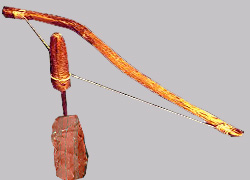
Old school bow drill
|
The advent of the
bow drill marked a pivotal turn in the history of bead
crafting. With this innovation, the flat, disc-shaped
beads of the past lost their allure as bead-makers
pushed the boundaries of their artistry in search of
greater refinement and sophistication.
Another technique:
Coring
Some ancient cultures, like the Egyptians, used a
technique called coring to drill holes in beads,
especially those made of softer stones like carnelian.
This involves drilling with a tubular drill bit, which
removes a cylindrical core from the bead, leaving a
perfectly round hole. The presence of a core or its
remnants can sometimes tell us about the drilling
techniques used.
As the Bronze Age unfolded, the bow drill catalyzed an
evolution towards beads of greater length, both in terms
of their overall dimensions and their drilled holes. It
was a transition that saw the rise of long, slender,
tubular beads which captured the imaginations of both
artisans and their patrons.
In the image below, you'll see an example of one such
elongated bead from the Indus Valley civilization. This
marked a significant departure from the earlier flat
bead designs, showcasing the transformative impact of
the bow drill on the aesthetic and functional aspects of
bead-making.
|
|
|
|

FAB 44 -
47 *
10,5
mm -
Aprox. age: 4.200 years
|
This bead pictured below is a testament to the evolving drilling
technology of the era. The hole in this bead was created
using one of the novel drill types that had been
introduced at the time. These drills could have been
constructed from sturdy stone materials like jasper or
chert, or could even have been copper drills tipped with
abrasive materials.
In the bead illustrated above, there's a noticeable
discrepancy in the diameters of the left and right
holes. This variance could suggest that the drills used
for perforation were only able to bore halfway through
the bead before deteriorating during the process. This
illustrates that, despite the advances in drilling
technology, creating elongated holes remained a
challenging and time-intensive task for the bead
artisans.
|
|
|
|
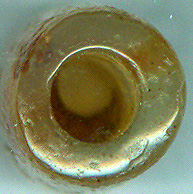
Left hole
|
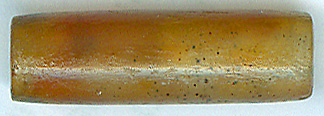
25 * 7 mm |
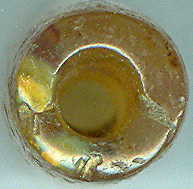
Right hole |
|
Drilling technology and length of the beads
The examples provided earlier clearly highlight how the
evolution of drilling technology significantly
influenced bead design and shape. The innate drive of
artisans to innovate and create works that surpass their
predecessors sparked the development of longer, more
intricate beads. This progression is markedly visible in
the culture of
Harappa
in the Indus Valley.
Harappan artisans began with a simple technique: pecking
to form a hole through a relatively flat, tabular bead.
This technique evolved to incorporate drilling with
tapered stone drills that were slightly harder than the
material of the bead itself. Finally, Harappans refined
exquisite drilling techniques specifically designed for
perforating long bead stones.
This specialized drilling method was jealously guarded
by the Harappans, which facilitated their creation of
beads that were longer and thinner than those produced
by any other contemporary culture. These slender,
delicate beads were admired and sought after all over
the known world during that time period. The material of
choice for these beads was uniformly colored carnelian.
Evidence of the widespread appeal of these beads can be
seen in the Mesopotamian Royal Cemetery of Ur, dating
back to 2450 BC, where a significant number of these
beads have been found. This reflects the value and
prestige associated with these unique and laboriously
crafted adornments.
Use of Abrasives
In many ancient cultures, the drilling of holes in beads
wasn't accomplished by the cutting action of the drill
alone. Abrasives, often in the form of sand or crushed
hard minerals, were used in combination with the
drilling tools. These abrasives would be caught in the
drill bit's grooves and would do much of the actual
cutting. The type of abrasive used can sometimes be
identified under a microscope, providing clues about the
origin of the bead. In the Indus times, jasper powder
was mostly used as an abrasive.
The rarest drilling abrasive:
Ernestite
Drilling
with Ernestite, because of their hardness and
durability, allowed Harappan artisans to carve beads
with greater finesse and detail. It facilitated the
creation of longer, more refined beads that became a
distinctive characteristic of the Harappan culture.
Its use was one of the best-kept secrets of the Harappan
civilization, giving them a technological advantage over
other cultures and increasing the demand for their
beautifully crafted beads.
This mineral, enriched with titanium, is believed to
have originated from Gujarat, an area that had extensive
trade links with the Harappan civilization. The use of
Ernestite as an abrasive is a testament to the Harappans'
technological innovation and their search for materials
that could improve their craft.
However, sourcing and utilizing Ernestite for
bead-making was not a simple process. The mineral had to
be painstakingly shaped into effective drilling tools,
which required an advanced understanding of mineral
properties and tool-making skills. Moreover, given the
rarity of the mineral, it's likely that its use was
highly regulated and reserved for the most skilled
artisans crafting the finest beads. These wonderful
elongated beads were only produced for a few hundred
years around 2.400 B.C.
|
|
|
|

Infinite Cascade
FAB 45
- 53 * 14 mm -
Aprox. age: 4.400 years
|
Hole Placement
The location and direction of the hole in a bead can
tell us something about its intended use and cultural
context. For example, a hole drilled from top to bottom
might suggest that the bead was meant to be strung
vertically as a pendant, while a hole drilled through
the middle could indicate use in a necklace or bracelet.
Illustrated below is a pendant hole:
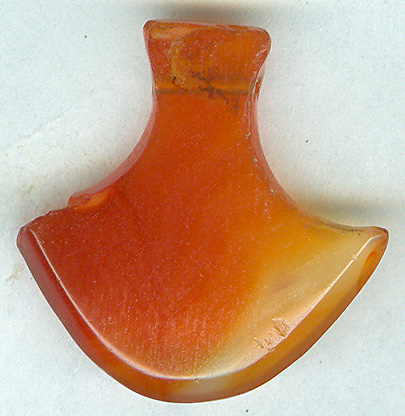
THE INVENTION OF THE DIAMOND DRILL
The invention of the diamond drill in India around 600
BC was a groundbreaking development in bead-making. This
tool enabled artisans to drill holes at an unprecedented
speed - over 200 times faster than previous methods! It
revolutionized the entire process, turning a laborious
and often unsuccessful task into a relatively simple
one.
The diamond drill, made from an extremely hard material,
could carve through even the hardest of stones with ease
and precision. It not only increased productivity but
also allowed for the creation of more intricate and
detailed designs, which was not possible with previous
drilling techniques.
Diamond drills also greatly improved the success rate of
bead-making. Earlier, the risk of breaking the bead
during the drilling process was high due to the pressure
exerted by the drill. But the diamond drill, with its
precision and efficiency, significantly reduced this
risk. This meant fewer wasted materials and less time
spent on unsuccessful attempts, leading to an overall
improvement in bead production.
Furthermore, the speed of the diamond drill allowed
artisans to experiment more with bead shapes and sizes.
This led to a proliferation of new bead designs and
styles, contributing to the rich variety of beads we see
in historical records.
|
|
|
|
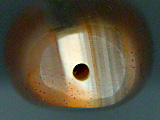
A new diamond drilled hole
 
29 * 4,5 mm
|
With the advent of the diamond drill, not only did bead
hole sizes become significantly smaller, but the
capability to craft larger and more slender beads also
expanded. This was due to the drill's ability to carve
precise, small holes without compromising the structural
integrity of the bead, something that was harder to
achieve with older drilling techniques.
In a rough approximation, the size of a bead's hole can
serve as an indicator of its age. Larger holes often
suggest the bead is relatively older, a result of less
advanced drilling methods. Conversely, smaller holes are
typically associated with more recent beads, a testament
to the precision of tools like the diamond drill.
The diamond drill also facilitated mass production of
beads. Prior to its invention, bead-making was a
time-consuming process due to the slow and careful
drilling required. However, with the diamond drill's
high speed and precision, artisans could rapidly produce
beads in large quantities, meeting higher demands and
enabling wider distribution. This innovation not only
impacted the quantity and quality of bead production,
but also transformed their role in commerce and culture,
making them more accessible across different societies.
|
|
|
|
|
Old drilling techniques in Cambey
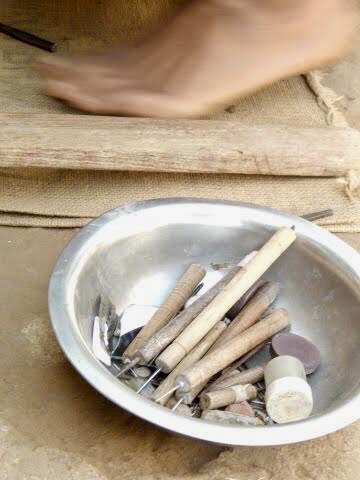
The above photograph
illustrates a simple, yet effective, setup for a diamond drill.
The key elements are an iron rod, a stick of wood or bamboo, and
a small diamond. The iron rod is attached to the stick or
bamboo, essentially serving as the drill bit. At the end of this
iron rod, a small diamond is meticulously secured. This
placement of the diamond at the tip of the iron rod is a
delicate process that requires great precision and
craftsmanship.
This diamond-tipped drill design brought about a significant
leap in bead-making technology. Diamonds, due to their extreme
hardness, have excellent cutting and abrasion properties. This
meant that the drill could bore through hard materials such as
agate, carnelian, and other types of stones used in bead
production, and do so with exceptional precision. Consequently,
artisans were now able to craft beads with very small holes, a
feature that was difficult, if not impossible, to achieve with
previous drilling techniques.
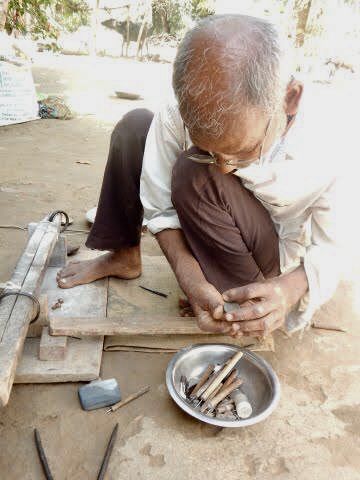
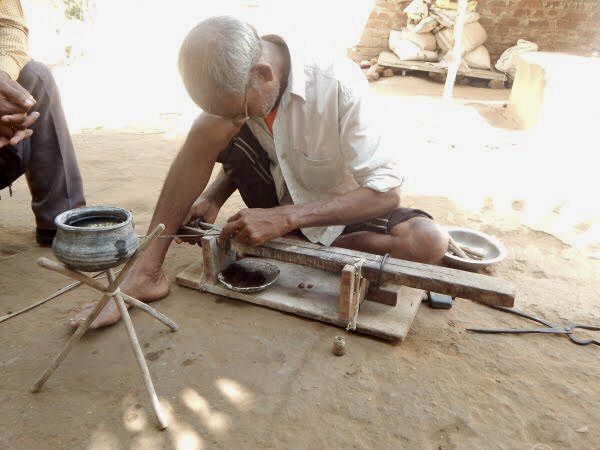
A bead maker from Cambey in
the process of drilling holes
|
|
|
|
|
|
|
|
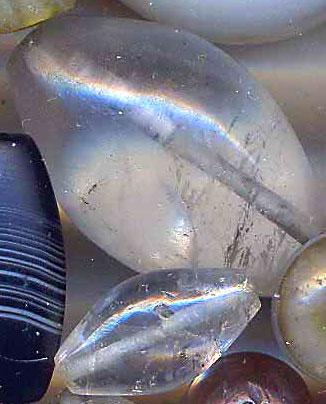
|
The Dual sided drilling Technique
The photo of the ancient
crystal beads above clearly shows the central
junction or 'meeting point' in each bead, which is a
mark of this dual-sided drilling process. This technique
becomes even more apparent when we examine translucent
beads, as shown in the golden carnelian bead below. The
remarkable joint in the center reveals the artisan's
careful work in aligning the drillings from both sides.
|
|
|
|
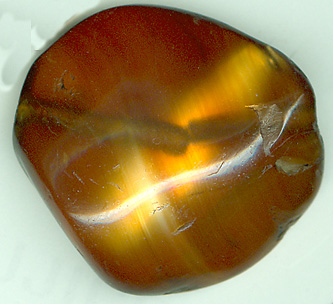
|
Re-drilling
In some cases, older beads have been re-drilled in more recent
times, either to enlarge a hole or to clean up a damaged one.
This can make the dating and classification of a bead more
complex.
|
|
|
|
|
|
THE HOLE AND THE STRING
A big hole denotes a very old bead. In ancient days,
arcane drilling technology
made it difficult to make small holes and the bead strings, made
out of natural materials,
were made thicker so that they would not break easily.
|
|
|
|
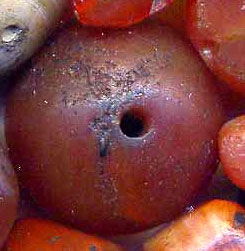
|
Wear and Tear by generations of strings
Over the course of many years, the action of a
string rubbing against the hole in a bead can change its
shape and smoothness. This can provide clues about the
bead's age and usage.
Beads worn on strings for multiple generations can
exhibit changes in the hole's shape due to natural wear
and tear. The opening of the hole, referred to as the
aperture, can reveal a great deal about the bead's life
story.
The hole's size in a bead holds key insights into its
age and the technology used in its creation. In ancient
times, the limitations of drilling technology made the
creation of smaller holes challenging, resulting in
larger hole diameters. Furthermore, the strings used to
thread beads, typically crafted from natural materials,
were thicker to ensure durability, necessitating larger
holes.
Over time, the friction between the string and the bead
hole results in gradual wear and polishing of the hole's
interior. If the bead material is relatively soft, or if
the string material is particularly hard, the bead hole
may become reshaped into an oval or otherwise modified
form. An example can be seen in the image below, where
the string's interaction with the bead over generations
has resulted in an elliptical or oval-shaped hole. The
softer the stone the greater impact the string will have
on the hole.
|
|
|
|
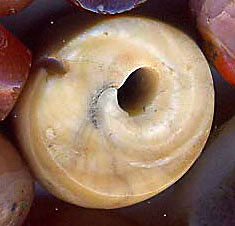
|
Due to the string, the hole can also develop a triangular shape:
|
|
|
|
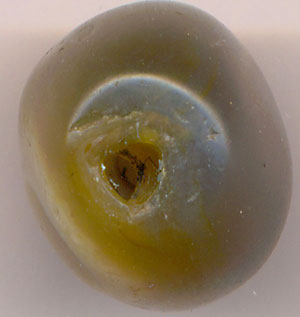
|
The bead displayed
above also exemplifies how beads rubbing against each
other on a string over time can create a polishing
effect. The ends of this bead have been worn down and
polished flat due to centuries of close contact with
neighboring beads on the same string.
The bead hole's characteristics can significantly aid in
verifying a bead's age. Taking a closer look at the bead
with the triangular hole, you'll notice the hole is
rough and jagged. This may be a telltale sign of a
counterfeit bead, as ancient hole-drilling techniques
generally resulted in smoother and more symmetrical
holes and we in this hole furthermore do not observe the
signs of the string polishing.
In contrast, an authentic ancient bead's hole typically
appears more refined and smoother. This is due to
centuries of wear and also the meticulous craftsmanship
of ancient artisans. An exemplary bead hole should
resemble the one shown below:
|
|
|
|

|
The interior
surface of the hole is a key location to find the signatures of age in a
bead. Consider the bead shown below. At first glance, the overall
surface of the bead might appear aged, but a closer examination of the
hole might reveal a different story. Is the hole's inner surface smooth
or rough?
A smooth hole typically suggests an authentic, ancient bead. This
smoothness comes from the wear and tear of centuries of use, with the
string rubbing against the bead hole, gradually polishing it. This
effect is hard to artificially replicate, making it a good indicator of
age.
In contrast, a rough or jagged interior to the hole could imply a newer
bead or even a counterfeit one. Often, modern or fake beads are
artificially weathered to look old on the surface but fail to
convincingly imitate the subtle aging of the hole's interior, a detail
frequently overlooked.
|
|
|
|
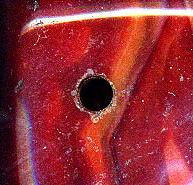
|
In the picture below you will see one
of my oldest beads. It is from the
early Indus Valley culture.
|
|
|
|
 
|
The bead-making tradition
of the Indus Valley Civilization is particularly
renowned for the precise and beautiful holes it
produced. The craftsmen of this ancient culture were
skilled in creating remarkably straight and smooth
holes, a testament to their high level of technical
ability and artistry. The meticulous crafting of these
holes added to the overall aesthetic appeal of the
beads, making them sought-after items in their time.
Below are more examples of these remarkable Indus Valley
bead holes:
|
|
|
|
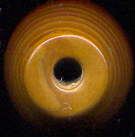  
|
Examining the masterful
holes crafted by the world's first bead makers is truly
fascinating. However, determining a bead's age and
origin based solely on one attribute can be challenging,
particularly in the case of ancient beads from 'Greater
India'. These beads were widely exported and travelled
as far as their human owners ventured.
Greater India was a diverse melting pot of various
cultures and societies, which existed side by side for
thousands of years. Each culture employed beads, but
their bead-making technologies varied. For instance, the
Harappan civilization crafted beads of significantly
greater complexity than many of the subsequent cultures.
This complexity and diversity make understanding the
history of beads a richly multifaceted subject, as every
culture added its own unique techniques and influences
to the art of bead making.
|
|
|
|
|
|
TECHNOLOGY AND BEADS
The evolution of technology
and its influence on beads and their perception in society is
truly fascinating. Whenever a new technology emerged that
allowed for easier mass production of beads, these adornments
gradually lost their exclusivity, moving from an elite status
symbol to objects of mass appeal. This shift invariably diluted
their allure among society's upper echelons, who sought rarity
and uniqueness in their talismans. Consequently, the continuous
technological advancements in bead production eventually caused
the semiprecious agate bead to lose its coveted position, being
overshadowed by more precious gemstones.
This process, however, was not linear. For instance, towards the
end of the Indus Valley era, the quest for exotic bead materials
somewhat counterbalanced this trend. As bead production became
more accessible, the rarity and uniqueness of the material
itself gained significant importance. This led artisans to seek
out distinctive materials and push the boundaries of their
craft, pursuing intricate designs and complex forms, such as
extraordinarily long and slender beads. They also invented more
sophisticated methods of etching and artificially coloring
beads, which eventually led to the creation of remarkable DZI
beads.
Nowadays, the allure of stone beads has been rekindled, with age
serving as the passport to prestige. An ancient bead,
irrespective of its material, is automatically elevated to a
status of desirability and charm. However, it's important to
note that the market is replete with beads carrying false claims
of age, posing a significant challenge for collectors and
enthusiasts in their quest for authentic ancient beads.
|
|
|
|
|
|
|
Litterature
Contemporary stone beadmaking in Khambat, India: Patterns of
craft specialization and organization of production as reflected
in the archaeological record
Jonatan Mark Kenoyer, Massimo Vidale and Kuldeep Kumar Bhan
The Important Stone and Metal Resources of Gujarat during the
Harappan Period
Randall Law
The beads from Taxilla
Horace Beck
Wikipedia
|
|
|
|